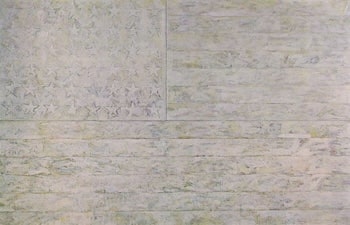White Flag, 1955 by Jasper Johns

Johns' early mature work, of the mid- to late 1950s, invented a new style that helped to engender a number of subsequent art movements, among them Pop, Minimal, and Conceptual art. The new style has usually been understood to be coolly antithetical to the expressionistic gestural abstraction of the previous generation. This is partly because, while Johns' painting extended the allover compositional techniques of Abstract Expressionism, his use of these techniques stresses conscious control rather than spontaneity.
White Flag is the largest of Johns's flag paintings and the first in which the flag is presented in monochrome. The lush reticence of the work perfectly exemplifies his early style. The fast-setting medium of encaustic enabled the artist to make each brushstroke distinct, while the forty-eight-star flag design contiguous with the perimeters of the canvas provided a structure for the richly varied surface, which ranges from translucent to opaque. White Flag is painted on three separately stretched panels of cotton: the star area, the seven upper stripes to the right of the stars, and the longer stripes below. Johns worked on each panel separately. After applying a ground of unbleached beeswax, he built up the stars, the negative areas around them, and the stripes with applications of collage: cut or torn pieces of newsprint, other papers, and bits of fabric. He dipped these into molten beeswax and adhered them to the surface. He then joined the three panels and overpainted them with more beeswax mixed with pigments, adding touches of white oil. This painting remained in the artist's collection until it was acquired by the Metropolitan Museum in 1998.
As Johns became well known and perhaps as he realized his audience could be relied upon to study his new work his subjects with a demonstrable prior existence expanded. In addition to popular icons, Johns chose images that he identified in interviews as things he had seen for example, a pattern of flagstones he glimpsed on a wall while driving. Still later, the "things the mind already knows" became details from famous works of art, such as the Isenheim Altarpiece by Matthias Grünewald (1475-5528), which Johns began to trace onto his work in 1981. Throughout his career, Johns has included in most of his art certain marks and shapes that clearly display their derivation from factual, unimagined things in the world, including handprints and footprints, casts of parts of the body, or stamps made from objects found in his studio, such as the rim of a tin can.
